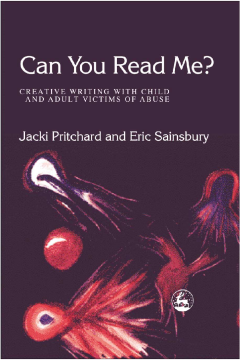
Additional Information
Book Details
Abstract
This book presents poems, stories and journal work spontaneously written by people, young and old, who have suffered serious abuse. The editors' explanations and commentaries suggest how health and social care workers can facilitate creative writing as a potential contribution to emotional healing in work with both individuals and small groups.
In addition to individual contributors, the book records the activities of groups developed by Barnardos for children and young people and by Beyond Existing for adults. Although not written as a training manual per se, the book offers photocopiable exercises and an appendix of writings for use in staff training.
Can You Read Me? illustrates the great potential for applying our creative imaginations and personal qualities like sensitivity in work with survivors of abuse and those with mental health and disability problems.
.
The first sixty-seven pages explore the creation of the book, understanding the origins of the work it presents and seeking to analyse it. These pages, in my opinion, concretise the book's real value. In my own experience as a counsellor with survivors of abuse, writing is frequently employed as a therapeutic tool but is less frequently well-understood. The book is clear and understandable. Various exercises are handily summarised in a series of readymade handouts, which may be photocopied and reused. This would be a valuable addition to the library of anyone working, or considering work, with survivors of abuse.
Lapidus
Occupational therapists will already be familiar with the principles of group work but the book demonstrates who the use of poetry can be used to order the chaos of the thoughts of the writers and describes the practical use of journals for workers in helping victims through the healing process. The book is also littered with useful snippets of advice. It is written in an economical, plain language sensitive to the subject matter and is deceptively quick to read as you are drawn in by the emotional raw poetry and writing it contains.
Mental Health Occupational Therapy Journal
The editors have succeeded in giving health care workers both the opportunity to increase their sensitivity and to develop responses that are caring and support emotional healing. This book is highly recommended for all health care professionals who provide therapeutic care to child and adult survivors of abuse and those who would like to experience an uplifting look into the resilience of the human spirit.
The International Journal of Psychiatric Nursing Research
The book is a guide to ways in which creative writing and personal disclosure help sufferers to express themselves and cope. There are a range of case studies, practical writing exercises and guidelines for facilitating groups and encouraging participants to develop self-esteem. The book is aimed at health and social care workers, but aids understanding and contains guidelines for those working with any writing group, in which a member may include a victim of abuse.
Writing in Education
Table of Contents
| Section Title | Page | Action | Price |
|---|---|---|---|
| INTRODUCTION ix | |||
| 1 The importance of storage 1 | |||
| 2 Principles of storage 2 | |||
| Temperature 2 | |||
| Moisture 3 | |||
| Keeping pests out of the store 3 | |||
| Control of pests in stores 5 | |||
| Storage characteristics of selected food commodities 6 | |||
| 3 Traditional storage methods 9 | |||
| Earthenware pots and gourds 9 | |||
| Leaves 10 | |||
| Bark 10 | |||
| Baskets 11 | |||
| Sacks 12 | |||
| Basket silos 13 | |||
| Roof storage 14 | |||
| Maize cribs 15 | |||
| Underground pits 16 | |||
| Clamp storage 16 | |||
| Small storehouses 17 | |||
| Earth silos 18 | |||
| 4 Improved storage techniques 19 | |||
| Plastic bags 19 | |||
| 45-gallon metal drums 20 | |||
| The Pusa bin 20 | |||
| Metal silos 21 | |||
| Brick and ferro-cement silos 22 | |||
| Storage in ventilated huts 23 | |||
| Improved pit storage 24 | |||
| 5 Socio-economic context 25 | |||
| Appraisal 25 | |||
| Technology choice 26 | |||
| Economic considerations 27 | |||
| Social and cultural considerations 28 | |||
| Monitoring and evaluation 29 | |||
| viii STORAGE | |||
| 6 Case studies 30 | |||
| Improvements to traditional grain stores in Zambia 30 | |||
| Flexible solar heat disinfestation devices for domestic and rural storage | |||
| of cereals in the tropics 31 | |||
| REFERENCES 32 | |||
| CONTACTS 34 |
